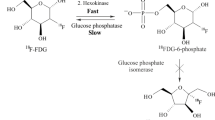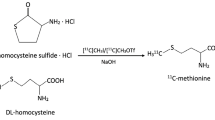Abstract
Positron emission tomography/computed tomography (PET/CT) is a standard procedure for imaging cancer commonly used in the clinical practice for several diseases, in particular for cancer staging, restaging, treatment monitoring and radiation therapy planning. Despite the availability of many radiotracers, 18F-fluoro-2-deoxy-2-d-glucose ([18F]FDG) is the most used. International PET/CT guidelines propose protocols for patients’ correct preparation before [18F]FDG injection, in particular with the regard of diabetic patients and therapy management. Hyperglycemic conditions and oral or insulin medication showed advantages and disadvantages on PET/CT scan accuracy: A correct knowledge of effects of these conditions on glucose metabolism assumes a fundamental role on patients management before [18F]FDG PET/CT scan.






Similar content being viewed by others
References
Gallamini A, Zwarthoed C, Borra A (2014) Positron emission tomography in oncology. Cancers (Basel) 6:1821–1889
Ido T, Wan C, Casella J et al (1978) Labeled 2-deoxy-d-glucose analogs: 18F labeled 2-deoxy-2-fluoro-d-glucose, 2-deoxy-2-fluoro-d-mannose and 14C-2-deoxy-2-fluoro-d-glucose. J Label Compd Radiopharm 14:175–183
Warburg OP, Negelein E (1924) Uber den stoffwechsel der carcinomzelle. Biochem Z 152:309–335
Potter M, Newport E, Morten KJ (2016) The Warburg effect: 80 years on. Biochem Soc Trans 44:1499–1505
Chen Z, Liu M, Li L, Chen L (2017) Involvement of the Warburg effect in non-tumor diseases processes. J Cell Physiol 2017:2839–2849
Larson SM (2006) 18 F-FDG imaging: molecular or functional? J Nucl Med 47:31N–32N
Pauwels E, Sturm E, Bombardieri E, Cleton F, Stokkel M (2000) Positron-emission tomography with [18F]fluoro-deoxy glucose, part 1. Biochemical uptake mechanism and its implication for clinical studies. J Cancer Res Clin Oncol 126:549–559
Theorens B, Sarkar H, Kaback H, Lodish H (1988) Cloning and functional expression in bacteria of a novel glucose transporter present in liver, intestine, kidney, and beta-pancreatic islet cells. Cell 55:281–290
Maher F (1995) Immunolocalization of GLUT1 and GLUT3 glucose transporters inprimary cultured neurons and glia. J Neurosci Res 42:459–469
Rea S, James D (1997) Moving GLUT4: the biogenesis and trafficking of GLUT4 storage vesicles. Diabetes 46:1667–1677
Kayano T, Burant C, Fukumoto H, Gould G, Fan Y, Eddy R et al (1990) Human facilitative glucose transporters. Isolation, functional characterization, and gene localization of cDNAs encoding an isoform (GLUT5) expressed in small, and adipose tissue and an unusual glucose transporter pseudogene-like sequence (GLUT6). J Biol Chem 265:13276–13282
Brown R, Wahl R (1993) Over expression of glut-1 glucose transporter in human breast cancer: an immunohistochemical study. Cancer 72:2979–2985
Kubota R, Yamada S, Kubota K, Ishiwata K, Tamahashi N, Ido T (1992) Fluorodeoxyglucose in vivo: high accumulation in macrophages and granulation tissues studied by microautoradiography. J Nucl Med 33(11):1972–1980
Mochizuki T, Tsukamoto E, Kuge Y, Kanegae K, Zhao S, Hikosaka K et al (2001) FDG uptake and glucose transporter subtype expressions in experimental tumor and inflammation models. J Nucl Med 42(10):1551–1555
Vaidyanathan S, Patel CN, Scarsbrook AF, Chowdhury FU (2015) FDG PET/CT in infection and inflammation—current and emerging clinical applications. Clin Radiol 70(7):787–800. https://doi.org/10.1016/j.crad.2015.03.010
Jamar F, Buscombe J, Chiti A, Christian P, Delbeke D, Donohoe K et al (2013) EANM/SNMMI guideline for 18F-FDG use in inflammation and infection. J Nucl Med 54(4):647–658
Randle P, Garland P, Hales C, Newsholme E (1963) The glucose fatty-acid cycle. Its role in insulin sensitivity and the metabolic disturbances of diabetes mellitus. Lancet 1(7285):785–789
Szabo Z, Xia J, Mathews W, Brown P (2006) Future direction of renal PET. Semin Nucl Med 36(1):36–50
Moran JK, Lee HB, Blaufox MD (1999) Optimization of urinary FDG excretion during PET imaging. J Nucl Med 40(8):1352–1357
Qiao H, Bai J, Chen Y, Tian J (2007) Kidney modelling for FDG excretion with PET. Int J Biomed Imaging 2007:1–4
Rosica D, Cheng SC, Hudson M, Sakellis C, Van Den Abbeele AD, Kim CK et al (2018) Effects of hyperglycemia on fluorine-18-fluorodeoxyglucose biodistribution in a large oncology clinical practice. Nucl Med Commun 39(5):417–422
Wahl R, Henry C, Ethier S (1992) Serum glucose: effects on tumor and normal tissue accumulation of 2-[F-18]-fluoro-2-deoxy-d-glucose in rodents with mammary carcinoma. Radiology 183:643–647
Diederichs C, Staib L, Glatting G, Beger H, Reske S (1998) FDG PET: elevated plasma glucose reduces both uptake and detection rate of pancreatic malignancies. J Nucl Med 39:1030–1033
Juweid ME, Cheson BD (2006) Positron-emission tomography and assessment of cancer therapy. N Engl J Med 354:496–507
Wahl RL, Jacene H, Kasamon Y, Lodge MA (2009) From RECIST to PERCIST: evolving considerations for PET response criteria in solid tumors. J Nucl Med 50(Suppl_1):122S–150S
Barrington SF, Kluge R (2017) FDG PET for therapy monitoring in Hodgkin and non-Hodgkin lymphomas. Eur J Nucl Med Mol Imaging 44(Suppl 1):S97–S110
Sprinz C, Zanon M, Altmayer S, Watte G, Irion K, Marchiori E et al (2018) Effects of blood glucose level on 18F fluorodeoxyglucose (18F-FDG) uptake for PET/CT in normal organs: an analysis on 5623 patients. Sci Rep 8(1):6–11
Büsing KA, Schönberg SO, Brade J, Wasser K (2013) Impact of blood glucose, diabetes, insulin, and obesity on standardized uptake values in tumors and healthy organs on 18F-FDG PET/CT. Nucl Med Biol 40(2):206–213. https://doi.org/10.1016/j.nucmedbio.2012.10.014
Eskian M, Alavi A, Khorasanizadeh M, Viglianti BL, Jacobsson H (2019) Effect of blood glucose level on standardized uptake value (SUV) in 18 F-FDG PET-scan: a systematic review and meta-analysis of 20, 807 individual SUV measurements. Eur J Nucl Med Mol Imaging 46:224–237
Yang J, Wen J, Tian T, Lu Z, Wang Y, Wang Z et al (2017) GLUT-1 overexpression as an unfavorable prognostic biomarker in patients with colorectal cancer. Oncotarget 8(7):11788–11796
Macheda ML, Rogers S, Best JD (2005) Molecular and cellular regulation of glucose transporter (GLUT) proteins in cancer. J Cell Physiol 202(3):654–662
Carvalho K, Cunha I, Rocha R, Ayala F, Cajaiba M, Begnami M et al (2011) GLUT1 expression in malignant tumors and its use as an immunodiagnostic marker. Clinics (Sao Paulo) 66:965–972
Varrone A, Asenbaum S, Vander Borght T, Booij J, Nobili F, Någren K et al (2009) EANM procedure guidelines for PET brain imaging using [18F]FDG, version 2. Eur J Nucl Med Mol Imaging 36(12):2103–2110
Boellaard R, Delgado-Bolton R, Oyen WJG, Giammarile F, Tatsch K, Eschner W et al (2014) FDG PET/CT: EANM procedure guidelines for tumour imaging: version 2.0. Eur J Nucl Med Mol Imaging 42(2):328–354
Delbeke D, Coleman RE, Guiberteau MJ, Brown ML, Royal HD, Siegel BA et al (2006) Procedure guideline for tumor imaging with 18F-FDG PET/CT 1.0. J Nucl Med 47(5):885–895
American College of Radiology (2016) ACR–SPR practice guideline for performing FDG-PET/CT in oncology. https://www.acr.org/-/media/ACR/Files/Practice-Parameters/FDG-PET-CT.pdf
Shankar L, Hoffman J, Bacharach S et al (2006) Consensus recommendations for the use of 18F-FDG PET as an indicator of therapeutic response in patients in National Cancer Institute Trials. J Nucl Med 47:1059–1066
Rena G, Hardie DG, Pearson ER (2017) The mechanisms of action of metformin. Diabetologia 60(9):1577–1585
Martin J, Saleem N (2014) 18F-FDG PET-CT scanning and diabetic patients: what to do? Nucl Med Commun 35(12):1197–1203
Massollo M, Marini C, Brignone M, Emionite L, Salani B, Riondato M et al (2013) Metformin temporal and localized effects on gut glucose metabolism assessed using 18F-FDG PET in mice. J Nucl Med 54(2):259–266. https://doi.org/10.2967/jnumed.112.106666
Gontier E, Fourme E, Wartski M, Blondet C, Bonardel G, Le Stanc E et al (2008) High and typical 18F-FDG bowel uptake in patients treated with metformin. Eur J Nucl Med Mol Imaging 35(1):95–99
Lee SH, Jin S, Lee HS, Ryu JS, Lee JJ (2016) Metformin discontinuation less than 72 h is suboptimal for F-18 FDG PET/CT interpretation of the bowel. Ann Nucl Med 30(9):629–636
Oh JR, Song HC, Chong A, Ha JM, Jeong SY, Min JJ et al (2010) Impact of medication discontinuation on increased intestinal FDG accumulation in diabetic patients treated with metformin. Am J Roentgenol 195(6):1404–1410
Huang S, Czech MP (2007) The GLUT4 glucose transporter. Cell Metab 5(4):237–252
Bryant NJ, Govers R, James DE (2002) Regulated transport of the glucose transporter GLUT4. Nat Rev Mol Cell Biol 3(4):267–277
Surasi DS, Bhambhvani P, Baldwin JA, Almodovar SE, O’Malley JP (2014) 18F-FDG PET and PET/CT patient preparation: a review of the literature. J Nucl Med Technol 42(1):5–13. https://doi.org/10.2967/jnmt.113.132621
Turcotte E, Leblanc M, Carpentier A, Bénard F (2006) Optimization of whole-body positron emission tomography imaging by using delayed 2-deoxy-2-[F-18]fluoro-d-glucose injection following I. V. insulin in diabetic patients. Mol Imaging Biol 8(6):348–354
Roy F-N, Beaulieu S, Boucher L, Bourdeau I, Cohade C (2009) Impact of intravenous insulin on 18F-FDG PET in diabetic cancer patients. J Nucl Med 50(2):178–183. https://doi.org/10.2967/jnumed.108.056283
Caobelli F, Pizzocaro C, Paghera B, Guerra UP (2013) Proposal for an optimized protocol for intravenous administration of insulin in diabetic patients undergoing 18F-FDG PET/CT. Nucl Med Commun 34(3):271–275
Song HS, Yoon JK, Lee SJ, Yoon SH, Jo KS, An YS (2013) Ultrashort-acting insulin may improve on18F-FDG PET/CT image quality in patients with uncontrolled diabetic mellitus. Nucl Med Commun 34(6):527–532
Garcia JR, Sanchis A, Juan J, Tomas J, Domenech A, Soler M et al (2014) Influence of subcutaneous administration of rapid-acting insulin in the quality of 18F-FDG PET/CT studies. Nucl Med Commun 35(5):459–465
Acknowledgements
We thank Dr. Francesca Paola Giunta Md for assistance with the English language and for comments that greatly improved the manuscript.
Author information
Authors and Affiliations
Corresponding author
Ethics declarations
Conflict of interest
The authors declare that they have no conflict of interest.
Statement of human and animal rights
This article does not contain research involving human or animal subjects.
Informed consent
For this type of study formal consent is not required.
Additional information
Managed by Massimo Federici.
Publisher's Note
Springer Nature remains neutral with regard to jurisdictional claims in published maps and institutional affiliations.
Rights and permissions
About this article
Cite this article
Finessi, M., Bisi, G. & Deandreis, D. Hyperglycemia and 18F-FDG PET/CT, issues and problem solving: a literature review. Acta Diabetol 57, 253–262 (2020). https://doi.org/10.1007/s00592-019-01385-8
Received:
Accepted:
Published:
Issue Date:
DOI: https://doi.org/10.1007/s00592-019-01385-8




